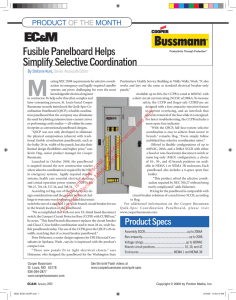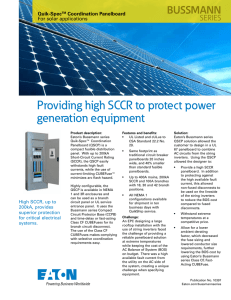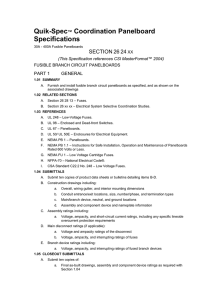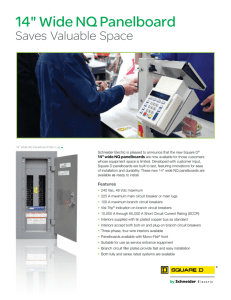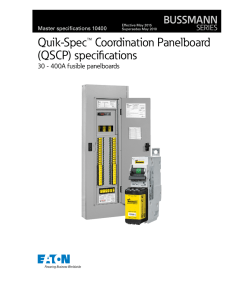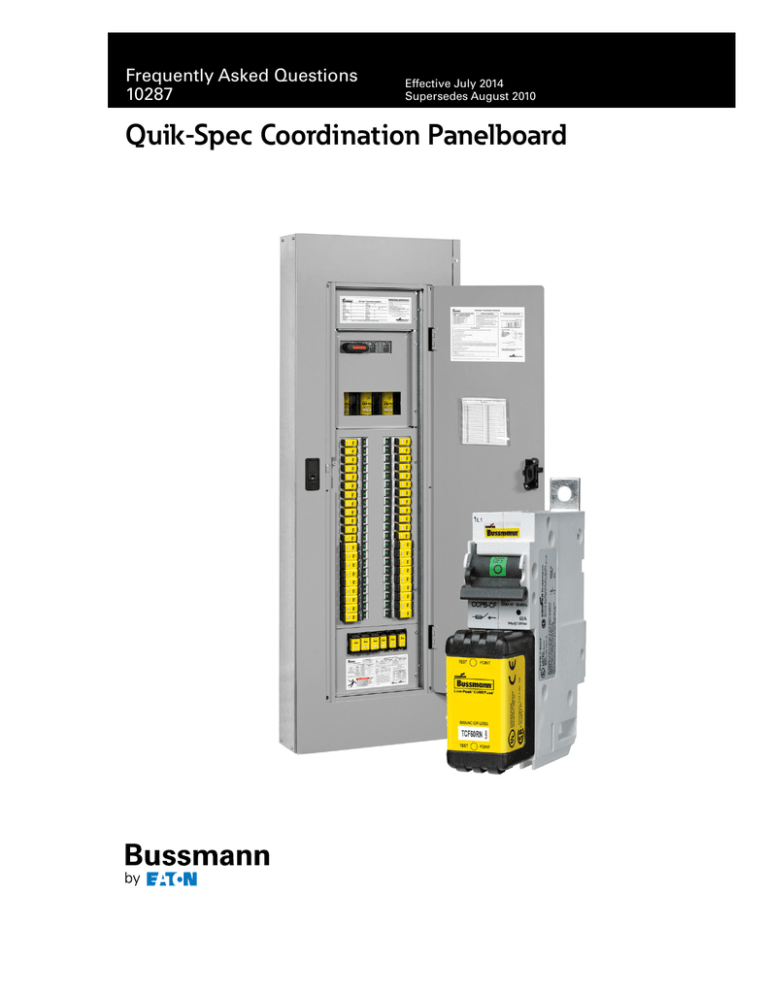
Frequently Asked Questions
10287
Effective July 2014
Supersedes August 2010
Quik-Spec Coordination Panelboard
Frequently asked questions 10287
Quick Spec Coordination Panelboard
Effective July 2014
Panel questions
1. Can the Quik-Spec Coordination Panelboard (QSCP)
be installed to meet the mandatory NEC® Selective
Coordination requirements?
Typically, there will be feeder and main fuses upstream of a
QSCP. As such, the entire circuit path needs to be selectively
coordinated. Thus, the Quik-Spec Coordination Panelboard by
itself is not the full solution. However, the QSCP is easy to
selectively coordinated in an all-fused system or with upstream
Eaton circuit breakers using published tables.
2. Can I specify Class CC fuses in the branch?
No, only the Class CF CUBEFuse with Class J performance is
used for branch fusing in this panelboard. This allows the amp
rating rejection feature to be implemented at key breaks of 15A,
20A, 30A, 40A, 50A, 60A, 70A, 90A & 100A. Also, using a
Class CC fuse would limit the circuit to 30 amps. With the
CUBEFuse, we can go up to 100A. For most motor branch
circuit applications, the CUBEFuse offers superior time-delay
compared to the Class CC fuses and therefore can be sized
closer than the Class CC fuses. This may permit a lower rated
CCPB and fuse amp rating as well as provide better short-circuit
protection.
3. Do I have to specify/populate all the branch circuit
positions?
No, whether ordering an 18, 30 or 42 position panelboard, after
specifying the number of positions to be filled on the chassis,
the balance will be left as open-space options for adding more
CCPBs later. If “spaces” are selected, the metal knockouts for
those branch positions are left in place. Should a branch
position be eliminated or moved, a metal cover is available to
fill the void left by the removed CCPB branch device.
4. Can the bus be extended in the field to allow additional
branch positions?
No, the total number of branch circuits must be decided at time
of ordering. If more branch circuits are needed, feed-throughlugs can be specified (or added in the field) to allow feeding
conductors to another panelboard.
5. Can feed-through lugs be added in the field?
Yes, the bus bars on all panelboards are able to accept the
addition of feed-through lugs. Service kits are available from
Bussmann.
6. Can a chassis be swapped in the field?
A chassis of similar size can be swapped out in the field. A
chassis of larger size cannot be retrofitted into a can of a smaller
chassis.
7. Can I install a circuit breaker in a branch circuit
position?
No, only the CCPB branch device can be used in this
panelboard. Rejection features in the design do not allow
installing circuit breakers.
0810
2
8. Is a 200% neutral an option?
Yes, a 200% neutral can be specified for nonlinear load
applications.
9. Is a Surge Protection Device an option?
Yes, a surge protection device can be applied on panels up to
480Vac. When including a surge protection device a load side
disconnect can not be included. For further details on the surge
protective device option, see the Quik-Spec Coordination
Panelboard Data Sheet No.1160.
10. Is the main disconnect field replaceable?
Yes, main disconnects can be replaced in an installation and are
stocked by Bussmann. You cannot replace a fused disconnect
with a non-fused disconnect or vise-versa.
11. Can you change a panelboard in the field from an MLO
to a main disconnect and vise-versa?
No.
12. Is the panel rated for service entrance?
Yes, when properly specified, configured and sold in the United
States, our UL file lists the Quik-Spec Coordination Panelboard
as being rated for service entrance.
13. Are both flush and surface mount panelboards
available?
Either flush or surface mount can be specified on a NEMA 1
panelboard. Whether a panelboard is flush or surface mount is
defined by the door. The enclosures, chassis and other
components remain the same. The NEMA 3R enclosure is
surface mount only.
14. Can a panelboard be converted from door-in-door
option to a standard door in the field?
Yes, the doors can be changed in the field.
15. Can a NEMA1 enclosure originally configured as a top
feed be altered for a bottom feed?
Yes, the panel chassis can be mounted in either direction.
Please contact your local Bussmann representative for new
labels as needed.
16. Can a panelboard be converted between flush and
surface mount in the field?
Yes, service kits are availble to allow a field change from flush to
surface mount and vice-versa. However, if changing from
surface to flush mounting, attention must be given to finished
wall thickness when mounting the enclosure.
17. Will the Quik-Spec Coordination Panelboard be
supplied with the fuses installed?
• Branch Circuits: The CUBEFuse branch circuit fuses will not
be installed, but will be shipped with the chassis for
installation at the jobsite. Fuses have to be removed to wire
each CCPB branch device. There is no time savings if they
are preinstalled.
Page 2 of 5
www.bussmann.com
PDF Only
Frequently asked questions 10287
Quick Spec Coordination Panelboard
Effective July 2014
• Fused Main Disconnect: 100A, 200A, and 400A fused main
disconnects will have fuses installed prior to shipment, saving
installation time. The fuses are installed under Bussmann
controlled and monitored conditions, and packed to meet
ISTA (International Safe Transit Association) shipping
standards. CUBEFuses on the CCP fused main disconnect
will not be installed, and will ship with the chassis for
installation at the jobsite.
18. How many branch circuit spare fuses are included with
the panel?
As a part of the total configured price, 10% or a minimum of
three extra spare fuses are specified at time of order and
included with the shipment. This aligns with bid requirements for
providing spares. For example: 3 spares for an 18-position, 3 for
a 30-position and 4 for a 42-position panelboard. The spare
fuse holder has capacity for six spare branch circuit fuses.
Additional spare fuses can be specified when ordering the
panel. Emergency fuse orders can be placed through Customer
Satisfaction.
Device questions
19. How does the CCPB handle an overcurrent? Does the
CCPB trip from the overcurrent? How does the CCPB
replace the two devices used in traditional fused/circuit
breaker panelboards?
The CCPB branch device (fuse holder and switch) and
CUBEFuse work independently to disconnect the circuit and
interrupt an overcurrent event. The CCPB is a manual
disconnect switch (UL 98) that does not trip during an
overcurrent event. In addition to being a disconnect, the CCPB
has an indication light to signal an open fuse. (Note: Illumination
requires the panelboard bus be energized, the circuit closed and
a minimum of 90Vac.) The Class CF CUBEFuse with Class J
performance is a fuse that interrupts the overcurrent event or
short-circuit event. Although they work independently, they are
interlocked to ensure an extra degree of safety. The CCPB
branch device must be turned OFF before the CUBEFuse can
be removed. The traditional fused/circuit breaker panelboards,
with a combination fuse holder and circuit breaker in each
branch are not interlocked and permit removing the fuse while
energized.
20. How does the CCPB branch device prevent overfusing?
The CCPB branch device and Class CF CUBEFuse with Class J
performance fuses are designed with ampacity rejection features
implemented at the key breaks of 15A, 20A, 30A, 40A, 50A,
60A, 70A, 90A & 100A. These match the key standard fuse
sizes and 75ºC copper conductor ampacities. This ensures
proper circuit protection at these ampacity breaks. For example,
the CCPB_40CF will accept up to a 40 amp CUBEFuse
(TCF40RN), but not a 50A or 60A CUBEFuse.
3
0810
www.bussmann.com
21. Can the CCPB branch device switch be locked in the
ON or OFF positions?
Yes, however, the hardware items are different for each:
• Lockout/Tagout requires using a 4mm shank lock or standard
lock with a “pin-out” device. Bussmann recommends the
Brady pin-out wide device P/N 90850 available through the
manufacturer or distributor.
• Lock-On (for emergency circuits) requires 1/16” safety wire
braid.
• Another option is a 3M PanelSafe Lockout System available
through Bussmann as a kit or 3M.
22. If a CUBEFuse opens, and the CCPB is turned to the
“OFF” position, will the indication light still be visible?
The CCPB branch device indication light will turn off when the
switch is turned OFF. If a contactor or starter downstream drops
out on loss-of-power, the CCPB indicating light will also turn off.
If an indicating CUBEFuse is used, it will still indicate when the
CCPB branch device is turned OFF.
23. Can the CUBEFuse branch fuse be removed under
load?
No, the CCPB branch device and CUBEFuse are interlocked to
ensure an extra degree of safety. The CCPB branch device
switch must be turned OFF to remove or install the CUBEFuse.
Service/support questions
24. Will cans be shipped in advance? Is there an additional
fee for this option?
Yes, cans will go out within one week of order receipt. The door
will ship with the chassis in a following shipment. If the cans and
chassis need to be shipped together please specify at the time
of order.
25. How are replacement CUBEFuse fuses obtained?
Replacement CUBEFuse fuses are available through any
Bussmann distributor. Emergency orders can be placed directly
with Bussmann through Customer Satisfaction.
26. How are replacement CCPB branch devices obtained?
Replacement Compact Circuit Protectors Bases (CCPBs) are
available through any Bussmann distributor. Emergency orders
can be placed directly with Bussmann through Customer
Satisfaction.
27. What type of standard and extended warranty is
available with this panelboard? What are the terms and
prices?
Bussmann warrants to each original buyer of products
manufactured by Bussmann that such products are, at the time
of delivery to the buyer, free of material and workmanship
defects for a period of 18 months from the date of shipment, or
12 months from the date of first use, whichever occurs first. The
extended warranty of 24, 30 or 36 months, must be purchased
in advance of product shipment, and it should be included in the
purchase order placed for items to be warranted.
Page 3 of 5
PDF Only
Frequently asked questions 10287
Quick Spec Coordination Panelboard
Effective July 2014
28. Will standard Coordination Panelboards be stocked at
Bussmann or at local distributors?
No, all base components (cans, doors, chassis, CCPB branch
devices, CUBEFuse fuses, etc.) will be stocked by Bussmann.
This allows replacement components to be shipped out next
day in service kits, and one week deliveries on enclosures.
29. What are the lead times for cans, chassis and complete
panelboards?
Enclosures are available for advanced shipment within one week
from order receipt. Chassis and completed panelboards ship
within four weeks of order receipt. A Quik-Ship option is
available for shipment of the entire unit in ten business days.
Application/standards questions
30.What is the Short-Circuit Current Rating (SCCR) of the
Coordination Panelboard?
Depending on the configuration that’s ordered, the panelboard’s
SCCR will be 20kA (DC only), 50kA, 100kA or 200kA. This is a
fusible solution (no series ratings permitted). The panelboard’s
SCCR rating must be equal to or greater than the available fault
current where it is installed.
31. Is the Quik-Spec Coordination Panelboard certified for
installation in areas subject to seismic rating
requirements?
Yes, this panelboard has Uniform Building Code (U.B.C.) and
California Building Code (C.B.C.) Seismic Qualifications and is
approved by the International Building code (I.B.C.).
Eaton’s Bussmann business
114 Old State Road
Ellisville, MO 63021
United States
www.bussmann.com
www.cooperbussmann.com/Quik-Spec
0810
© 2014 Eaton
All Rights Reserved
Printed in USA
Publication No. 10288 BU-SB14524
July 2014
Eaton is a registered trademark.
All other trademarks are property
of their
respective
owners.
Page
4 of 5
PDF Only

